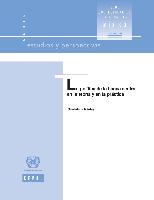- Biblioteca CEPAL
- Biblioguias
- biblioguias
- Raúl Prebisch and the challenges of development of the XXI century
- The central banking system and monetary policy
Raúl Prebisch and the challenges of development of the XXI century
The central banking system and monetary policy in the centre and the periphery: Prebisch as a central banker and “monetary physician”
In the economies of the centre and periphery alike, monetary policy and central banks played an eminently passive role during most of the nineteenth and the beginning of the twentieth century. This was partly due to the fact that most countries adopted fixed exchange-rate regimes, the central pillar of which was the gold standard.
The First World War and its repercussions prompted monetary activism in the economies of the centre, and in particular the United States, a trend which peaked in the 1920s. In the periphery, the shift towards monetary activism came later, following the Great Depression, and that activism was in full swing in the 1940s. Traditionally, monetary policy in Latin America had been inspired by the recommendations of the pre-Keynesian economic orthodoxy of the missions in the 1920s and 1930s by Edwin Kemmerer, Sir Otto Niemeyer and F. J. Powell . Guidelines for monetary policy management advocated an independent central bank and, above all, a monetary policy that would support fiscal stability, which meant that they were clearly procyclical.
However, the impact of the Great Depression and its repercussions in the countries of the periphery called into question these recommendations and gave rise to a shift in monetary policy. The Central Bank of the Republic of Argentina (1935) (BCRA), governed by Prebisch from 1935-1943 and under the guidance of Federico Pinedo (1895-1971), played an anti-cyclical role, using a series of instruments including exchange-rate policy, the build-up of reserves, capital controls and open-market operations. The Bank also acted as lender of last resort and, on some occasions, supported in part an expansionary fiscal policy. This experience of the BCRA and difficulties in managing an economy with external problems served as an intellectual training and, to some extent, account for the ideas developed subsequently by Prebisch.
Expansionary policies were maintained during the period of the Good Neigbor Policy introduced by the United States under the Administration of Franklin Delano Rossevelt. This Policy provided strong support to public investment and development banking, while promoting the establishment of more stable monetary and financial systems, which were less vulnerable and better able to respond to the shocks of the business cycle. Starting in the mid-1940s, the Treasury and subsequently the United States Federal Reserve organized a series of missions (to Paraguay, Dominican Republic and Venezuela), headed for the most part by Robert Triffin (1911-1993).
Triffin invited Raúl Prebisch to collaborate on these missions and highlighted his influence on proposals for reform of the banking system in those countries. The two policymakers agreed that financial systems should address the needs of the countries of Latin America and should not be servile imitations of the banking regimes in the major financial centres. These reforms gave a wide range of functions to the central bank including maintenance of monetary stability but, above all, adaptation of monetary policy to the needs of production, plus a definite and obvious countercyclical role. These ideas have lost none of their relevance today.
The impact of the debt crisis of the 1980s, the ensuing stabilization and structural reforms, the belief in market efficiency that progressively took hold and the tendency to delegitimize the role of the State led to a prolonged decline in active and countercyclical monetary policies. The recent crisis (2007-2009) has, however, brought these mechanisms back into focus. Nevertheless, monetary policy continues to maintain a marked bias towards price stability and pays scant attention to the effects on the long-term growth path of economies, contrary to the situation in the 1940s when this approach was very much present.
Esteban Pérez Caldentey y Matías Vernengo - Banco Central de Argentina (BCRA), Profesor de la University of Utah y Comisión Económica para América Latina (CEPAL), respectivamente.
The opinions expressed herein are the sole responsibility of the authors and may not coincide with those of the BCRA and ECLAC.
Interviews
Esteban Pérez: Prebisch y la banca central (2013 - 4:14)
Osvaldo Sunkel: Prebisch, creador de instituciones (2013 - 3:14)
Esteban Pérez: Prebisch y los ciclos económicos (2013 - 2:16)
Related documents
-
 Bancos centrales “periféricos”: el caso de América Latina
by
Publication Date: 2015En: Estructura productiva y política macroeconómica. Enfoques heterodoxos desde América Latina. Santiago: CEPAL, LC/G.2653-P. p. 135-162
Bancos centrales “periféricos”: el caso de América Latina
by
Publication Date: 2015En: Estructura productiva y política macroeconómica. Enfoques heterodoxos desde América Latina. Santiago: CEPAL, LC/G.2653-P. p. 135-162 -
 La política de la banca central en la teoría y en la práctica
by
Publication Date: 2012Serie Estudios y Perspectivas (México, DF) No. 137. 59 p. LC/L.3528 - LC/MEX/L.1066
La política de la banca central en la teoría y en la práctica
by
Publication Date: 2012Serie Estudios y Perspectivas (México, DF) No. 137. 59 p. LC/L.3528 - LC/MEX/L.1066
